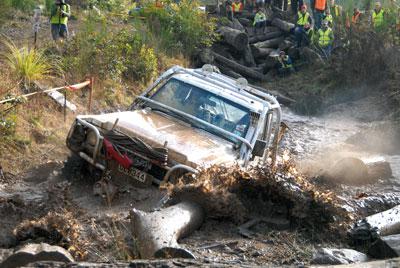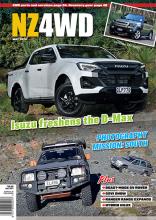|
I read a very interesting piece of information the other day. Modern diesel engines emit only 15 percent of the nitrous oxides and other pollutants than diesel engines made more than 10 years ago. That’s an amazing figure, and I know that if we look at petrol engines we will see also gains in pollution saving, though probably not as much as the diesel figure. Why am I bothering with this in the 4WD context? Because one of the many fingers pointed at us, the 4Wheeling community, is that we drive heavily-polluting “gas-guzzling” vehicles that tramp all over the countryside, inferring that everything we do is anti-social and even evil! We know better, and that there are more 4WDs that never go off-road than those of us who do, and the anti-social element of the 4WD community is restricted to a few people who will always be anti-social and ill-disciplined no matter what their hobbies are. But the fact remains that older 4WDs DO create more pollution than newer ones. At the same time more pollution normally equates to more fuel used, and in this day and age when we are continuously bombarded by fuel increases (they go up and down but the general direction is always up) the more you can save on fuel, the better off you’re going to be. Many 4WD owners want more power from their vehicles, too, especially to give them the extra torque for low-down lugging – whether it’s to get out of a mud hole, tow a boat or off-road trailer, or just to ensure you can get to the top of those long, go-on-forever, hills. You can always go the engine swap route, of course, but unless you’re clever enough to do the work yourself, and have a fully-equipped workshop and even a bit of engineering knowhow, this is not for the fainthearted. And overall a bigger engine will usually use more fuel, especially if you use all the power that’s available. Sometimes, though, it’s the best way for what you want, and there are lots of really top-class engineering workshops out there which will help you. But always remember that putting in a much more powerful engine, especially one which multiplies the torque, will put a lot more stress onto the running gear of your 4WD. If your vehicle was made for a 300 Nm 2-litre engine, trying to put 500 Nm through the same drivetrain will often highlight a weak point in the system, and something will probably let go. So what we’re trying to say is that an engine swap alone is only the start of the story, and you have to look at the whole drivetrain – even strengthening of the bodywork itself in some cases – before you attempt such a major transplant. However, for the last 20 years or so engines have been controlled by ECU (electronic control units – mini computers), which regulate everything from the supply of fuel to the engine right through to the ABS braking system, stability programmes and traction control, as well as the “nice to haves” such as high descent programmes. However, as with most things in this PC world of ours, the ECU is generally set for “Mr Average” in terms of how the engine operates, and theses settings will ensure the engine won’t be damaged no matter what the driver tries to do to it – even the idiots. As a result many manufacturer computer maps are very rich when it comes to fuel mixture, as well as having “lazy” timing maps to allow for different fuel quality around the world It’s much like the old adage “Jack of all trades, master of none”. However, for those who are more careful, responsible, and knowledgeable when it comes to driving a vehicle, this means they are losing out on the full potential of the engine. Enter the chip. No, we’re not talking the delicious potato-based food, here, but the heart of the ECU – the computer chip. |
Although these are set by the factory, as mentioned, they CAN be swapped, or their settings altered, to give you more power and economy, and provided you don’t push the boundaries of the engine too much, you’ll still get the same reliability as before. What’s more the power and economy gains of re-chipping come at a much lower cost than replacing your engine with a bigger one. However, not all chips are created equal, and although there are gains to be had provided you choose the right chip for your vehicle, you can end up with little or no gain if you don’t choose carefully. On turbocharged engines hot chips usually increase the manufacturer’s boost limit settings so the turbo boost can be cranked up. This can give hefty performance increases, especially on turbo-diesel vehicles that are more conservatively tuned by default. Of course, over-pumping your turbo can also wreck it, and more cylinder pressure can encourage pre-ignition, or pinging. So make sure you use a reputable workshop and system to prevent this. There are other ways you can improve your engine’s efficiency before you get to the expense of changing your chip. For instance reusable air filters. This is a part that the tree huggers love: air filters which can be used over and over again. That’s right, no need to clog up our landfills with paper filters. Instead, air filters built for race cars can be put in your 4WD and reused. Your engine breathes better and a better breathing engine sucks up less fuel so your fuel economy improves! Cold air intakes. Designed to suck up colder, denser air, a cold air intake delivers the oxygen that your engine wants. Again, your engine runs smoother and fuel economy increases. Performance exhausts. A standard exhaust inhibits power so your engine works harder and uses more fuel in the process. With the wider pipes found in a performance exhaust system you can get more power, achieve greater torque, and watch your fuel economy rise as your engine and exhaust work in harmony. And they don’t have to be noisier than the standard item if they’re properly designed. As we said, more power equals more fuel in, but it also means more exhaust gas out, and sometimes you end up having to replace not only the chip, but the radiator (a more powerful engine often runs hotter) or even a new gearbox or a transfer case to deliver your newfound power to the vehicle’s wheels. All of these components are equally important to each other, and we must always remember this synergy among the parts.
|



